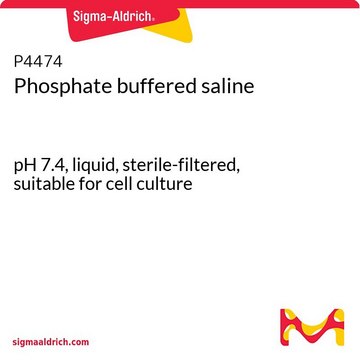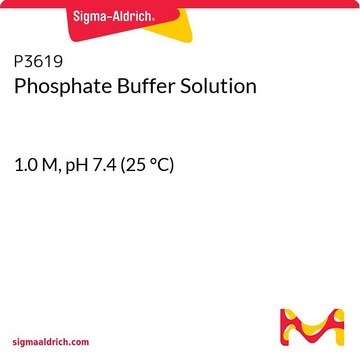806552
Solution tampon phosphate
pH 7.4, liquid, sterile-filtered, suitable for cell culture
Synonyme(s) :
PBS
About This Item
Produits recommandés
Stérilité
sterile-filtered
Forme
liquid
Technique(s)
cell culture | mammalian: suitable
Impuretés
Endotoxin, tested
pH
7.4
Vous recherchez des produits similaires ? Visite Guide de comparaison des produits
Description générale
Application
- as a reagent in the isolation of human endometrial stem cell/stromal cells (hEnSCs) from the endometrium or menstrual blood
- has also been used to wash cells during immunofluorescence staining
- as a solvent for the glucose administered orally in the Glucose Tolerance Tests (GTTs)
Code de la classe de stockage
12 - Non Combustible Liquids
Classe de danger pour l'eau (WGK)
nwg
Point d'éclair (°F)
Not applicable
Point d'éclair (°C)
Not applicable
Certificats d'analyse (COA)
Recherchez un Certificats d'analyse (COA) en saisissant le numéro de lot du produit. Les numéros de lot figurent sur l'étiquette du produit après les mots "Lot" ou "Batch".
Déjà en possession de ce produit ?
Retrouvez la documentation relative aux produits que vous avez récemment achetés dans la Bibliothèque de documents.
Les clients ont également consulté
Protocoles
WST-1 assay protocol for measuring cell viability, proliferation, activation and cytotoxicity. Instructions for WST-1 reagent preparation and examples of applications. Frequently asked questions and troubleshooting guide for WST-1 assay.
MTT assay protocol for measuring cell viability, proliferation and cytotoxicity. Instructions for MTT reagent preparation and examples of applications.
Protocol Guide: XTT Assay for Cell Viability and Proliferation
MTT assay protocol for measuring cell viability, proliferation and cytotoxicity. Instructions for MTT reagent preparation and examples of applications.
Notre équipe de scientifiques dispose d'une expérience dans tous les secteurs de la recherche, notamment en sciences de la vie, science des matériaux, synthèse chimique, chromatographie, analyse et dans de nombreux autres domaines..
Contacter notre Service technique










